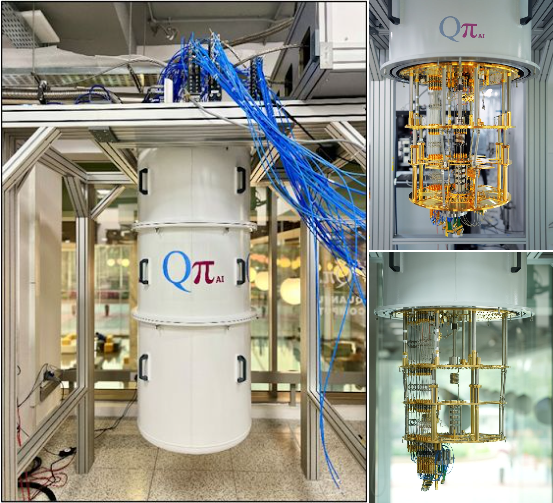
- The National Quantum Mission (NQM) is India’s ambitious plan to advance quantum technology with the target of developing intermediate-scale quantum computers on superconducting and photonic platforms with 50-1,000 physical qubits within 8 years.
- Bengaluru-based QpiAI-Indus, one of eight startups selected under NQM, unveiled QpiAI-Indus, India’s most powerful quantum computer with 25 superconducting qubits, on World Quantum Day.
- India’s investment in NQM, while significant, pales in comparison to the billions spent by China, which claims to have built a quantum computer that is quadrillion times faster than the world’s best supercomputer.
- With sustained investment, streamlined processes, and a focus on talent, India could replicate its IT success, transforming the quantum landscape by the 2030s.
Quantum computing, a revolutionary technology that promises to solve problems beyond the reach of classical computers. In India, the pursuit of this cutting-edge futuristic tech is aiming to carve a niche, driven by the desi tadka of Quantum Electronics, the National Quantum Mission (NQM). India’s most powerful quantum computer, with 25 superconducting qubits, QpiAI-Indus, has been launched on World Quantum Day. With contributions from academia like IITS, startups like QuNu Labs and of course, government organisations like DRDO, NQM is poised to leapfrog into the Quantum arena. India’s quantum journey shall be marred with challenges, sure, but the land of Upanishads that inspired Schrodinger to disrupt the limitations of Classical Physics in the first place, is going to be a formidable contender in the Quantum world.
The National Quantum Mission: A Blueprint for Progress
The National Quantum Mission, approved in April 2023 with a budget of ₹6,003.65 crore (approximately $720 million) for 2023-2031, is India’s ambitious plan to advance quantum technology. The mission targets the development of intermediate-scale quantum computers on superconducting and photonic platforms with 50-1,000 physical qubits within eight years. It also aims to establish satellite-based quantum communications over 2,000 kilometres and multi-node quantum networks.
The NQM has set Thematic Hubs (T-Hubs), namely Quantum Computing, Quantum Communication, Quantum Sensing & Metrology and Quantum Materials & Devices, in the four Premier IITs ready to take up the Quantum test. The T-Hubs aim to foster research designed to bridge academia and industry, encouraging innovation and workforce development, bringing 14 Technical groups to work together across 17 states and 2 union territories. The mission’s focus on practical applications, such as cryptography and drug discovery, underscores its goal to integrate quantum technology into real-world solutions. With 385 proposals already received, the NQM is poised to accelerate India’s quantum ecosystem, though challenges like funding delays and global competition remain.
Clearing all debates on funding, Ajai Chowdhry, Chairperson, Quantum Mission Governing Board, to the Government of India, said, “The government is very clear that if required in any particular technology, they will put the funding required.” He also emphasised the need for private sector involvement and inter-nation partnership like the Indo-US Science and Technology (ISET) agreement, which incorporates active dialogues to enhance quantum technological standards.
The NQM’s structure is a forward-thinking model, focusing on scalability and collaboration. By investing in multiple qubit platforms, India edges against the uncertainties of Quantum Technology domination. The mission also prioritises quantum error correction, a critical hurdle for practical quantum computers, as qubits are prone to decoherence, where a quantum bit, different from a binary bit, loses its state due to quantum interaction of particles with the environment, degrading the performance and reliability of the Quantum Algorithm.
QpiAI-Indus: The 6-Qubit Milestone to 25-Qubit Leap
A landmark achievement in India’s quantum journey came in August 2024, when scientists from the DRDO Young Scientists Laboratory for Quantum Technologies (DYSL-QT) and the Tata Institute of Fundamental Research (TIFR) successfully tested a 6-qubit quantum processor system in entanglement with each other. This processor, developed in collaboration with Tata Consultancy Services (TCS), demonstrated end-to-end functionality, executing quantum circuits via a cloud-based interface and delivering results. TIFR’s novel ring-resonator qubit design and DYSL-QT’s use of custom and off-the-shelf electronics showcased India’s ingenuity in hardware development.
The latest buzz is India taking the 6-Qubit Milestone to leap into a 25-Qubit Quantum Computer. Bengaluru-based QpiAI-Indus, one of eight startups selected under India’s National Quantum Mission (NQM) led by the Department of Science & Technology (DST), unveiled QpiAI-Indus, India’s most powerful quantum computer with 25 superconducting qubits, on World Quantum Day. This marks the country’s first full-stack quantum computing system, targeting transformative advancements in life sciences, drug discovery, materials science, logistics, climate action, and sustainability through AI-enhanced quantum solutions. The company also revealed a roadmap for fault-tolerant quantum systems using error-corrected logical qubits: a prototype logical qubit platform (Yukti) by 2026, a 5-logical-qubit system (Shakti) by 2027, and a 100-logical-qubit platform (Unnati) by 2030, targeting commercial scalability.
Since its inception in 2019, QpiAI has filed 11 patents and generated ₹1 million in annual revenue, supported by funding from institutions like SIDBI. Its innovations aim to make quantum computing accessible and globally competitive. While still behind the global leaders like IBM’s 1121-qubit Condor, this marks a critical step toward scalable quantum computing, with plans to reach 1000 qubits in five years, aligning with NQM goals.
Strides in Quantum Research: The role of Indian Academia
The recent strides in the Quantum communication, cannot be complete without the exceptional work done by Indian Institute of Technology, Delhi, where Dr Bhaskar Kanseri and his team achieved 380 kms of node free Quantum communication being the first Nation globally for the Differential Phase Shift (DPS), Quantum Key Distribution (QKD) protocol, keeping IIT Delhi and India at the forefront of research and development in quantum communication technologies. This was after a 100 km communication was established between Vindhyachal and Prayagraj by a joint Team of DRDO and IIT Delhi. Think of it like wireless communication, but with no medium whatsoever, not even air. It’s like you needn’t even be transmitting the original signal, but you will still be transmitting information. You will be transmitting an encrypted quantum key on the physical communication channel. When the quantum bits (Qubits) are changed to a spin state at one end, the other end changes automatically to its opposite spin. And even if the key is intercepted, nobody can ever decipher it. What a lunatic thievery it would be to have the key without the lock. That is the incredible magic of Quantum Entanglement.
Now, the Research scholars in India can use a e-lab, a one-of-a-kind, National Quantum lab based on a cloud platform using high-quality simulators to test their quantum computing algorithms. The Ministry of Electronics and Information Technology (MeitY), partnered with Amazon Web Services (AWS) to launch the Quantum Computing Applications Lab, the country’s first cloud-based platform providing researchers and developers access to quantum tools for accelerating R&D, aimed at advancing national scientific missions.
Photonic Quantum Computing: Startups Leading the Charge
India’s private sector is making waves in quantum technology, with startups like QpiAI and BosonQ pushing boundaries. A notable player is Quanfluence, which is developing India’s first photonic quantum computer. Unlike superconducting systems, Photonic systems, which use photons as qubits, operate at room temperature and integrate well with communication networks, making them ideal for quantum cryptography and networking. Then we have QNu Labs incubated at IIT Madras Research Park, which is developing scalable photonic technology for applications like secure communication and complex optimisation. QNu Labs is deploying the globe’s first end-to-end quantum-safe heterogeneous system, combining free-space QKD with indigenous innovations, single-photon detectors (SPD), encryptors, Quantum Hardware Security Modules (QHSM), and a software-defined QKD controller. Photonic systems face challenges, such as photon loss and the complexity of generating entangled states, but their potential for long-distance quantum communication makes them strategic. QuNu Labs’ work complements academic efforts, like those at the Raman Research Institute, which explores quantum optics. By fostering startups, India is creating a vibrant ecosystem where innovation thrives alongside research.
CDAC’s Quantum Reference Facility: Building Infrastructure
India is set to establish a Quantum Computing Reference Facility within three years, as announced by C-DAC (Centre for Development of Advanced Computing). This facility, part of the NQM, will serve as a testing and validation hub for quantum technologies, enabling researchers and industries to benchmark systems against global standards. Expected to be operational by 2027, this facility, part of the NQM, will serve as a testing and validation hub for the development of quantum algorithms, hardware, and software, fostering interoperability and innovation. C-DAC’s expertise in high-performance computing enhances the project’s credibility, but challenges like funding and timely execution remain.
Global Chess: India’s Quantum Diplomacy
Partnering with Taiwan for chips, Israel for encryption, and France for quantum satellites, India is playing 4-D chess. Why? The idea is to dodge US-China tech-cold wars and the recent tariff madness. India’s partnerships with Israel and Australia aim to develop a 50-qubit quantum computer by 2026, pooling expertise and resources. The Quantum Computing Applications Lab, backed by the Ministry of Electronics and AWS, provides cloud access to quantum platforms, enabling researchers to experiment without costly hardware. However, India must balance collaboration with self-reliance, as over-dependence on foreign technology could limit sovereignty in critical areas like defence and cryptography. By blending global insights with indigenous innovation, India can build a robust quantum ecosystem that competes on the world stage.
India’s Quantum Quest: A Jugaad or Genuine Leap?
Qubit scaling is a technical challenge, as larger systems increase decoherence and require advanced error correction. With its 6-Qubit System entangled system, India isn’t far behind when it comes to the core technology. The claim for the maximum number of entangled Qubits in a system is 51, while the one successfully used for computation is 27. The 25-qubit Quantum Computer, while a milestone, is far from the 1,000 logical qubits achieved worldwide. Financially, India’s ₹6,000 crore investment, while significant, pales against the billions spent by the U.S. and China. China claims to have built a quantum computer that is quadrillion times faster than the world’s best supercomputer. Bureaucratic delays, as raised by notable dignitaries like TIFR’s Rajamani Vijayaraghavan, slow the process of equipment procurement and funding approvals, hampering research pace. India imports most quantum components, raising costs and risks due to geopolitical restrictions.
India’s quantum saga is pure chaos theory. The NQM’s a start. Photonic qubits are a wildcard. CDAC is still in early stages. The 6-qubit milestone and upcoming reference facility demonstrate momentum. With sustained investment, streamlined processes, and a focus on talent, India could replicate its IT success, transforming the quantum landscape by the 2030s.
But let’s not kid ourselves: this isn’t a sprint. It’s a decade-long grind not based on guarantees but survival. Will India leapfrog? Perhaps. But right now, it’s less “quantum supremacy” and more “quantum survival.” And survival? That’s something the land of Bharatvarsh has done for millennia. But for now, the quantum revolution in India feels less like an enthusiastic bang and more like a slow, steady ting.
Abhinav is an accomplished Engineer, Technical Writer and consultant, who has worked for prestigious Navratna PSUs of India. He is an expert on matters related to Defense and Technology. Views are personal.
